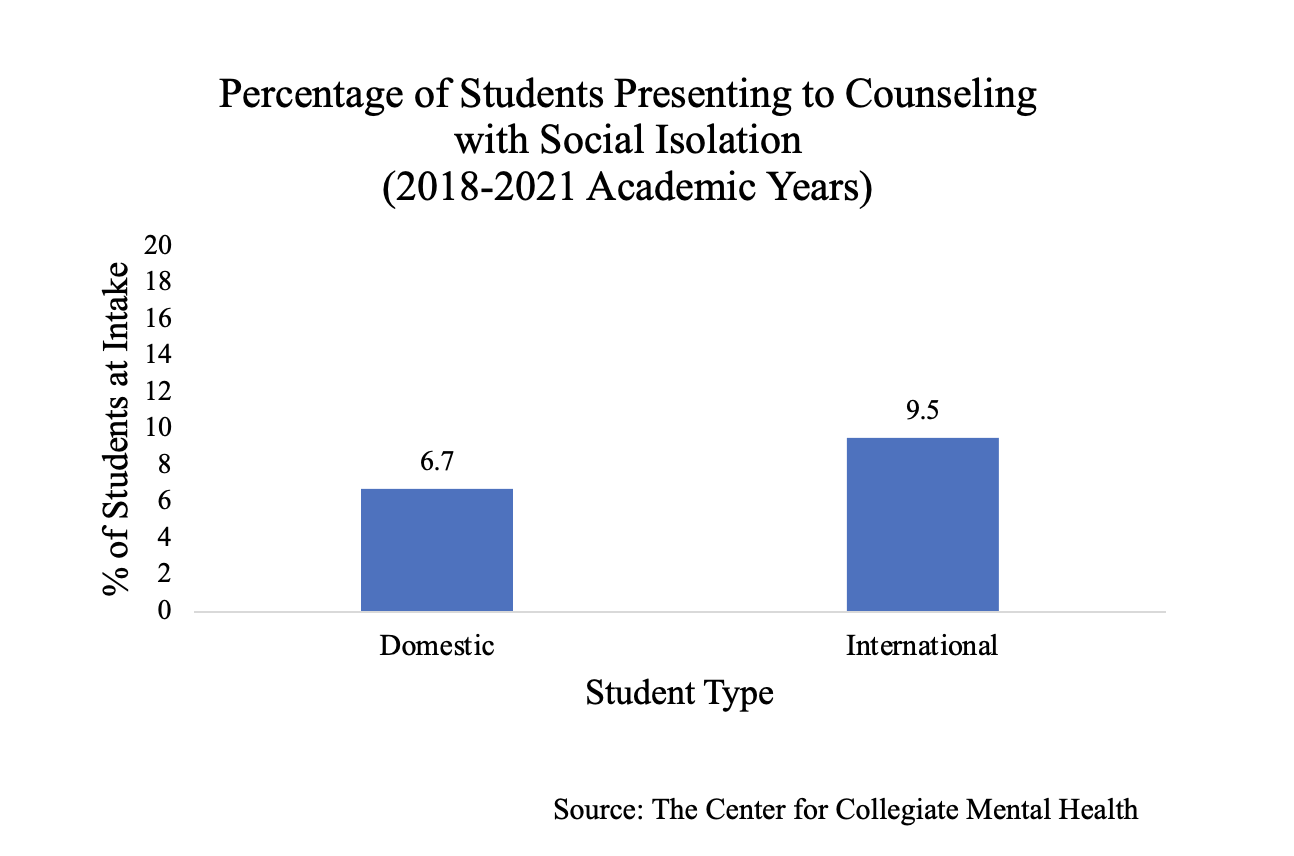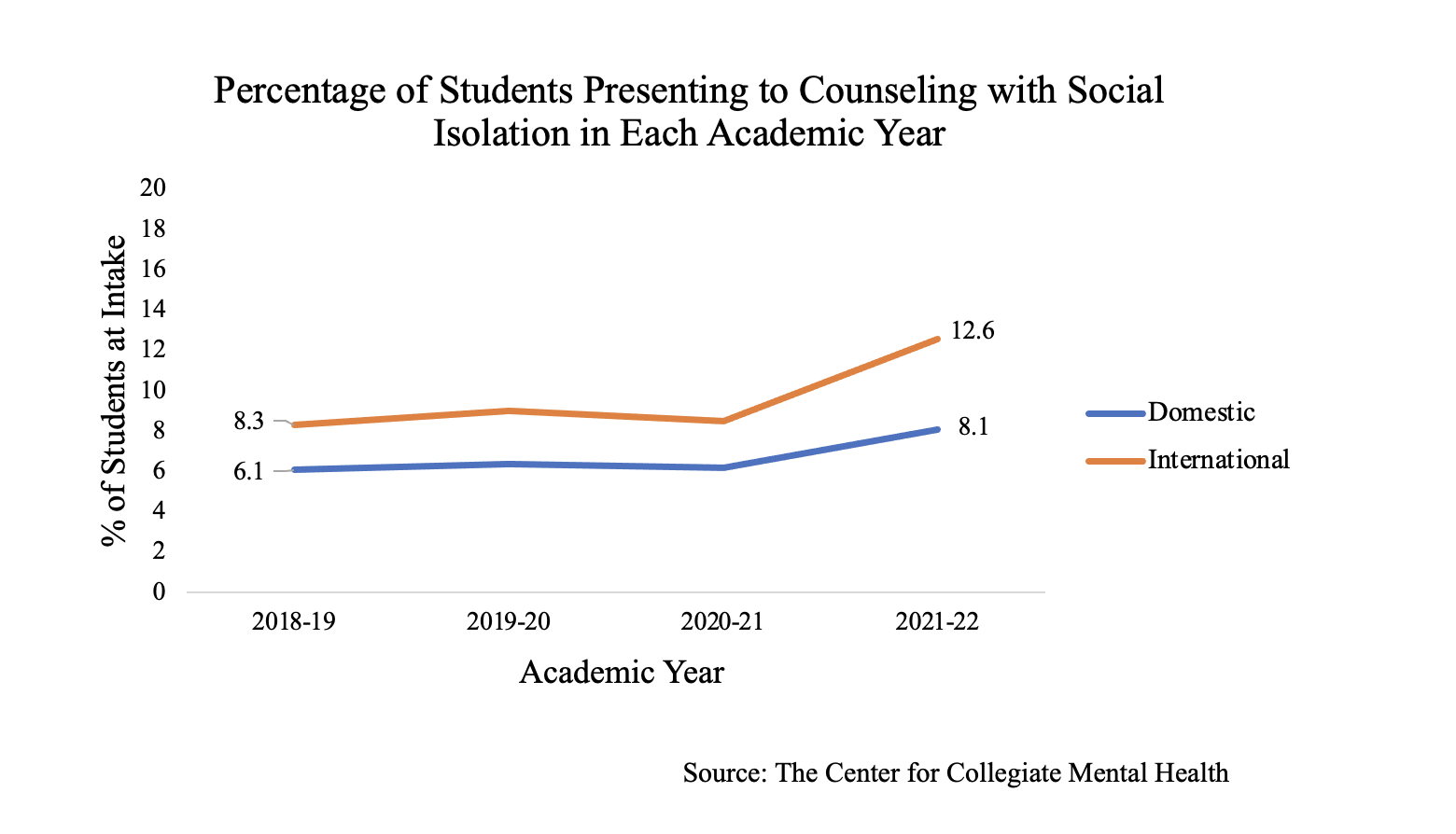International Students Are More Socially Isolated than Domestic Students, and the Gap Is Growing After COVID-19
International students in the United States consistently report higher rates of social isolation than their domestic peers (Prieto-Welch, 2016; Smith & Khawaja, 2011). Some research suggests that this disparity has grown during the COVID-19 pandemic due to the transition to online learning, fewer opportunities for in-person social activities, and increased discrimination faced by international students (Al-Oraibi et al., 2022; Koo & Jiang, 2022; Maleku et al., 2022). As colleges and universities transition to more sustained post-pandemic operations, understanding recent changes in social isolation among international students could help institutions provide them with appropriate support. Additionally, examining changes in social isolation among international students at college counseling centers could inform recommendations for students who are struggling the most and clarify impacts of social isolation on mental health symptoms. In this blog, we explore three questions about social isolation among international students attending colleges and universities within the United States:
- Are international students receiving services at college counseling centers more likely to present with social isolation than domestic students?
- Have the differences in social isolation between international and domestic students in counseling changed during the COVID-19 pandemic?
- How is social isolation associated with international students’ mental health symptoms when they present to counseling?
To answer these questions, we examined data submitted to the Center for Collegiate Mental Health (CCMH) by member counseling centers during the 2018-2019 through 2021-2022 academic years. This included data from 377,269 domestic student clients and 25,946 international student clients from 188 college counseling centers in the United States. We defined social isolation as a counselor selecting “Social isolation” as one of the client’s problems on the Clinician Index of Client Concerns (CLICC) at the client’s first counseling appointment.
Are international students receiving services at college counseling centers more likely to present with social isolation than domestic students?
Approximately 6.7% of domestic students and 9.5% of international students presented to college counseling centers with social isolation from fall 2018 through spring 2022 (see Table 1 below). This indicates that across all years examined, the proportion of international students presenting with social isolation was approximately 42% higher than for domestic students. This was a statistically significant difference (95% confidence interval of the odds ratio: [1.36, 1.49]).

Note. Numbers are the percentage of students whose counselor selected “Social Isolation” as one of their presenting concerns on the CLICC. International students were significantly more likely than domestic students to present to counseling with social isolation from 2018-2021.
Have the differences in social isolation between international and domestic students in counseling changed during the COVID-19 pandemic?
From the 2018-2019 to the 2020-2021 academic years, the proportion of international students with social isolation ranged from 2.2-2.6 raw percentage points higher than domestic students (see Table 2 below). Rates of social isolation were higher for all students in the 2021-2022 academic year. However, the difference in social isolation between international and domestic students grew to 4.5% during that year. In other words, the difference in rates of social isolation between international and domestic students nearly doubled after the onset of COVID-19.

Note. Numbers are the percentage of students whose counselor selected “Social Isolation” as one of their presenting concerns. The difference in social isolation between international and domestic students nearly doubled in the 2021-2022 academic year.
How is social isolation associated with international students’ mental health symptoms when they present to counseling?
Across the 2018-2019 through 2021-2022 academic years, international students who presented to counseling with social isolation reported higher levels of symptoms on the Counseling Center Assessment of Psychological Symptoms (CCAPS) than those without social isolation (see Table 3 below). This was true for all subscales of the CCAPS except Substance Use (see Appendix for t-test results). The top three types of symptoms that were higher among those with social isolation were Depression, Social Anxiety, and Academic Distress.

Note. On average, international students who presented to counseling with social isolation reported higher levels of symptoms in all areas except Substance Use. CCAPS: Counseling Center Assessment of Psychological Symptoms.
Summary and Implications
The following takeaways are noted:
- Clinicians identified nearly one in ten international students (9.5%) as experiencing social isolation, and overall, the proportion of international students presenting with social isolation was nearly 42% higher than the proportion of domestic students with social isolation concerns.
- Rates of social isolation were consistently higher for international students across the four academic years being examined (2018-19 through 2021-22), and the difference further increased after the onset of COVID-19.
- International students with social isolation reported more severe mental health symptoms than domestic students on seven out of eight CCAPS subscales (all but Substance Use). Depression, Social Anxiety, and Academic Distress were the top three mental health symptoms (subscales) that were higher for international students with social isolation compared to those without.
- Counseling centers and their respective institutions should recognize that international students tend to report higher rates of social isolation than domestic students, and this gap has widened considerably since the COVID-19 pandemic. Clinicians can address this disparity at the outset of treatment by exploring international students’ experiences of the pandemic and remote learning as well as assessing the quality of their interpersonal relationships and social connections. Additionally, opportunities exist for counseling centers to collaborate with campus partners in various offices including global/international programs, residence life, and new student orientation to provide targeted support to international students, offer opportunities for meaningful social connection, and promote intercultural learning. Social isolation is not inherently a mental health issue and international students will benefit from institutions adopting a model of shared responsibility for creating campus environments that foster social and interpersonal connectedness.
- Given prior research findings that international students often face discrimination and that this discrimination can contribute to mental health symptoms, clinicians should be intentional about examining international student’s experiences of discrimination and perceptions of campus climate, particularly as the U.S. heads into the 2024 election year. Due to the current social and political climate characterized by increasing polarization, rise of hate group activity, and resurgence of xenophobic attitudes, clinicians should make space for clients to process possible experiences of discrimination and understand how those incidents may amplify social isolation and associated mental health symptoms for international students.
References
Al-Oraibi, A., Fothergill, L., Yildirim, M., Knight, H., Carlisle, S., O'Connor, M., Briggs, L., Morling, J. R., Corner, J., Ball, J. K., Denning, C., Vedhara, K, & Blake, H. (2022). Exploring the psychological impacts of COVID-19 social restrictions on international university students: A qualitative study. International Journal of Environmental Research and Public Health, 19(13), 7631. https://doi.org/10.3390/ijerph19137631
Koo, K. K., & Jiang, M. (2022). What does it mean to take online classes as an international student during COVID-19?. Online Learning, 26(4), 209-230. Retrieved from https://olj.onlinelearningconsortium.org/index.php/olj/article/view/3495/1219
Maleku, A., Kim, Y. K., Kirsch, J., Um, M. Y., Haran, H., Yu, M., & Moon, S. S. (2022). The hidden minority: Discrimination and mental health among international students in the US during the COVID‐19 pandemic. Health & Social Care in the Community, 30(5), e2419-e2432. https://doi.org/10.1111/hsc.13683
Prieto‐Welch, S. L. (2016). International student mental health. New Directions for Student Services, 2016(156), 53-63. https://doi.org/10.1002/ss.20191
Smith, R. A., & Khawaja, N. G. (2011). A review of the acculturation experiences of international students. International Journal of Intercultural Relations, 35(6), 699–713. https://doi.org/10.1016/j.ijintrel.2011.08.004
Appendix
Results of t-tests comparing CCAPS subscale scores between international students with and without social isolation

Note. Numbers in the first two columns are mean CCAPS scores at the first administration. CCAPS-62: Counseling Center Assessment of Psychological Symptoms-62.
This blog post was written by Wilson T. Trusty, Ph.D., and Caitlin Chun-Kennedy, Ph.D.

